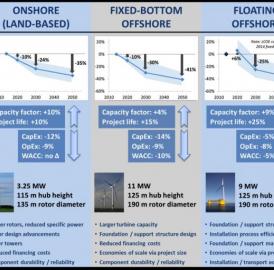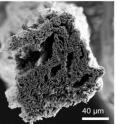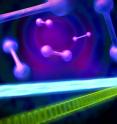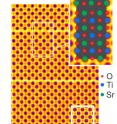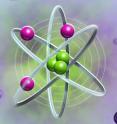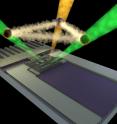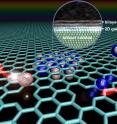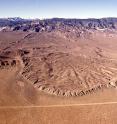Popular Science articles about Physics & Chemistry
Manipulation of liquid crystals could help control drug-delivery process
Liquid crystals are strange substances, both fish and fowl. They can flow like a liquid, but have the orderly molecular structure of a crystalline solid. And that internal structure can...
New laser provides ultra-precise tool for scientists probing the secrets of the universe
Researchers have developed a new laser that makes it possible to measure electron transition energies in small atoms and molecules with unprecedented precision. The instrument will help scientists test one...
Researchers prototype system for reading closed books
 MIT researchers and their colleagues are designing an imaging system that can read closed books.
MIT researchers and their colleagues are designing an imaging system that can read closed books.
UMD physicists discover 'smoke rings' made of laser light
 Most basic physics textbooks describe laser light in fairly simple
terms: a beam travels directly from one point to another and,
unless it strikes a mirror or other reflective surface,...
Most basic physics textbooks describe laser light in fairly simple
terms: a beam travels directly from one point to another and,
unless it strikes a mirror or other reflective surface,...
Measuring forces in the DNA molecule
 DNA, our genetic material, normally has the structure of a twisted
rope ladder. Experts call this structure a double helix. Among
other things, it is stabilized by stacking forces between...
DNA, our genetic material, normally has the structure of a twisted
rope ladder. Experts call this structure a double helix. Among
other things, it is stabilized by stacking forces between...
Incubating climate change
A group of James Cook University scientists led by Emeritus Professor Ross Alford has designed and built an inexpensive incubator that could boost research into how animals and plants will...
New perovskite research discoveries may lead to solar cell, LED advances
 "Promising" and "remarkable" are two words U.S. Department of Energy's Ames Laboratory scientist Javier Vela uses to describe recent research results on organolead mixed-halide perovskites.
"Promising" and "remarkable" are two words U.S. Department of Energy's Ames Laboratory scientist Javier Vela uses to describe recent research results on organolead mixed-halide perovskites.
New sensor could help fight deadly bacterial infections
 Scientists have built a new sensor that can detect the potentially
deadly E.coli bacteria in 15-20 minutes, much faster than
traditional lab tests. E.coli can be transmitted in
contaminated food...
Scientists have built a new sensor that can detect the potentially
deadly E.coli bacteria in 15-20 minutes, much faster than
traditional lab tests. E.coli can be transmitted in
contaminated food...
For first time, carbon nanotube transistors outperform silicon
 For decades, scientists have tried to harness the unique properties
of carbon nanotubes to create high-performance electronics that are
faster or consume less power -- resulting in longer battery life,...
For decades, scientists have tried to harness the unique properties
of carbon nanotubes to create high-performance electronics that are
faster or consume less power -- resulting in longer battery life,...
3-D graphene has promise for bio applications
 Flakes of graphene welded together into solid materials may be suitable for bone implants, according to a study led by Rice University scientists.
Flakes of graphene welded together into solid materials may be suitable for bone implants, according to a study led by Rice University scientists.
Water helps assembly of biofibers that could capture sunlight
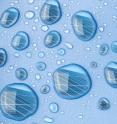 When it comes to water, some materials have a split personality - and some of these materials could hold the key to new ways of harnessing solar energy.
When it comes to water, some materials have a split personality - and some of these materials could hold the key to new ways of harnessing solar energy.
Chemists offer enhanced 3-D look inside batteries
 A team of chemists has developed a method to yield highly detailed,
three-dimensional images of the insides of batteries. The
technique, based on magnetic resonance imaging (MRI), offers an enhanced...
A team of chemists has developed a method to yield highly detailed,
three-dimensional images of the insides of batteries. The
technique, based on magnetic resonance imaging (MRI), offers an enhanced...
PPPL researchers successfully test device that analyzes components within a vacuum
 Physicists at the U.S. Department of Energy's (DOE) Princeton
Plasma Physics Laboratory (PPPL) have successfully tested a new
device that will lead to a better understanding of the interactions between...
Physicists at the U.S. Department of Energy's (DOE) Princeton
Plasma Physics Laboratory (PPPL) have successfully tested a new
device that will lead to a better understanding of the interactions between...
Scientists expect to calculate amount of fuel inside Earth by 2025
 Earth requires fuel to drive plate tectonics, volcanoes and its
magnetic field. Like a hybrid car, Earth taps two sources of energy
to run its engine: primordial energy from assembling...
Earth requires fuel to drive plate tectonics, volcanoes and its
magnetic field. Like a hybrid car, Earth taps two sources of energy
to run its engine: primordial energy from assembling...
A more accurate sensor for lead paint
A new molecular gel recipe developed at the University of Michigan is at the core of a prototype for a more accurate lead paint test.
New material to revolutionize water proofing
 Scientists at The Australian National University (ANU) have developed a new spray-on material with a remarkable ability to repel water.
Scientists at The Australian National University (ANU) have developed a new spray-on material with a remarkable ability to repel water.
Tapping the unused potential of photosynthesis
 Scientists from the University of Southampton have reengineered the fundamental process of photosynthesis to power useful chemical reactions that could be used to produce biofuels, pharmaceuticals and fine chemicals.
Scientists from the University of Southampton have reengineered the fundamental process of photosynthesis to power useful chemical reactions that could be used to produce biofuels, pharmaceuticals and fine chemicals.
Tuning the instrument: Spider webs as vibration transmission structures
Two years ago, a research team led by the University of Oxford revealed that, when plucked like a guitar string, spider silk transmits vibrations across a wide range of frequencies,...
Location matters in the self-assembly of nanoclusters
 Scientists at Iowa State University have developed a new
formulation that helps to explain the self-assembly of atoms into
nanoclusters and to advance the scientific understanding of related
nanotechnologies. Their...
Scientists at Iowa State University have developed a new
formulation that helps to explain the self-assembly of atoms into
nanoclusters and to advance the scientific understanding of related
nanotechnologies. Their...
'Materials that compute' advances as Pitt engineers demonstrate pattern recognition
 PITTSBURGH (September 2, 2016) ... The potential to develop
"materials that compute" has taken another leap at the University
of Pittsburgh's Swanson School of Engineering, where researchers
for the first...
PITTSBURGH (September 2, 2016) ... The potential to develop
"materials that compute" has taken another leap at the University
of Pittsburgh's Swanson School of Engineering, where researchers
for the first...
Stanford engineers develop a plastic clothing material that cools the skin
Stanford engineers have developed a low-cost, plastic-based textile that, if woven into clothing, could cool your body far more efficiently than is possible with the natural or synthetic fabrics in...
More news about Physics & Chemistry
Physics News in Images
Breaking science news from the newsfeed about Physics & Chemistry
- The quest to crystallize time
- New enzyme-like tool lets chemists modify hard-to-reach spots on drug molecules
- Chemists Create Molecular 'Leaf' That Collects and Stores Solar Power Without Solar Panels
- Researchers take big step forward in nanotech-based drugs
- In Photos: Building the Superfast 'Hyperloop One' Transit System of the Future
- Argonne Invents Reusable Sponge That Soaks Up Oil, Could Revolutionize Oil Spill and Diesel Cleanup
- Cancer-causing benzene found in e-cigarette vapors operated at high power
- The sky is the limit for new low-cost 3D printer
- New technology platform propels the use of 'organs-on-chips'
- Paper pumps power portable microfluidics, biomedical devices
- U.S. Naval Research Lab develops light, transparent armor
- Travelling through scattering tissue with far less light
- Atomic resolution of muscle contraction
- Small Nanoparticles Have Surprisingly Big Effects on Polymer Nanocomposites
- Lawsuit alleges Boeing at fault for MH370 crash
- Researchers Propose Technique for Measuring Weak or Nonexistent Magnetic Fields
- Leonardo subsidiary to buy laser technology company Daylight Solutions
- Towards mastering terahertz waves?
- The selection of archaeological research material should be re-evaluated
- China's coal use, mould money and Russia's new doping lab
- Detailed chemical structure of P22 virus resolved
- Kristen Stewart goes platinum blonde with new buzzcut
- Ultrafast detection of a cancer biomarker enabled by innovative nanobiodevice
- Pilot dies in crash of ultralight aircraft in Hesperia, Calif.
- WikiLeaks claims Samsung TVs enable surveillance
- Adapt or die, head of Norwegian energy company Statoil says
- Texas energy sector recovery in its infancy
- Gravitational waves pioneer Ron Drever dies
- Ants adapt surprisingly quickly to rising city temperatures
- Going Glassy: Revealing Structure and Dynamics of Glassy Polymers During Transition
